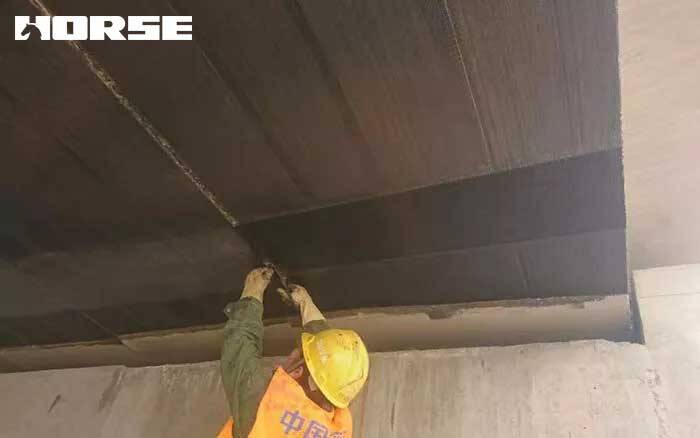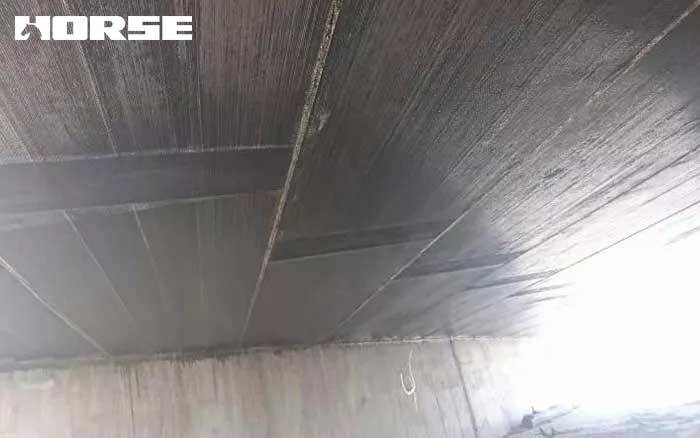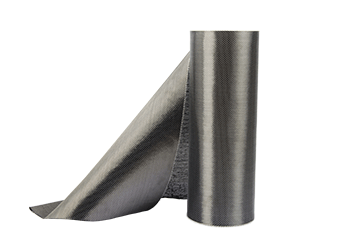Solutions
Horse Construction offers full range of structural strengthening materials with technical supports, documentation supports, products supports, project supports.
fiber reinforced polymer in bridge reinforcement

Generally speaking, bridges need to be strengthened due to various reasons, including the increase in traffic volume, the poor quality and technology of the bridge in the early years, long-term disrepair, natural and man-made disasters, etc.
Traditional reinforcement methods include physical reinforcement, that is, outside the bridge concrete structure is reinforced with outer steel, hoop, welding reinforcement, and adding fulcrums. Chemical reinforcement method, that is, reinforcement by means of grouting. These methods can play a certain role in maintenance and reinforcement, but they also show their limitations, including affecting the appearance of the bridge, polluting the environment, easily causing damage to the original bridge structure, and increasing the load on the bridge structure.
Fiber Reinforced polymers (Fiber Reinforced plastic) reinforcement method refers to the use of an adhesive to directly adhere fiber-reinforced polymer materials to the surface of the bridge concrete structure under normal temperature conditions to help the concrete bear part of the force, thereby improving the bridge's mechanical performance and achieving the purpose of repair and reinforcement . Fiber reinforced polymers have the advantages of light weight, high strength, corrosion resistance, fire resistance, low pollution, and convenient construction. Fiber-reinforced polymer reinforcement method is currently a new type of reinforcement technology commonly used in developed countries such as the United States and Europe. It can be used in various civil engineering and has also attracted more and more national engineering circles' attention
1 The characteristics of fiber reinforced polymers
1.1 Advantages of fiber reinforced polymers in bridge reinforcement
Fiber-reinforced polymers generally include carbon fiber reinforced polymers (Carbon Fiber Reinforced polymers), aramid fiber reinforced polymers (Aramid Fiber Reinforced polymers), and glass fiber reinforced polymers (Glass Fiber polymers). The advantages of fiber reinforced polymers include:
1) High strength and high efficiency. Fiber-reinforced polymers are usually composed of raw materials such as carbon atoms stacked and connected to form a fibrous structure, mixed with epoxy resin as an adhesive, and the two interact with each other to have high strength and elastic modulus. At the same time, it can effectively adhere to the surface of the bridge concrete structure, thereby achieving the purpose of improving the bearing capacity and ductility of the overall bridge structure, thereby increasing the bridge's flow and seismic capacity.
2) Easy to construct. When fiber-reinforced polymers are used for reinforcement construction, wet work is particularly required, and large construction equipment and fixed equipment are not required at the same time. The construction is convenient and occupies a small area. At the same time, the fiber-reinforced polymer is a flexible material before curing, with good fit and strong adhesiveness of epoxy resin. Even if there are bubbles on the surface of the fiber-reinforced polymer after curing, the resin injection method can be used to fill the bubbles.
3) Wide range of use. Bridges with different structural shapes and different structural parts of bridges, including large bridges that are difficult to construct with traditional reinforcement methods, can be reinforced with fiber reinforced polymers, without increasing the quality and size of the bridge, and without affecting the appearance of the bridge.
4) Flexible design. Fiber-reinforced polymers have a fibrous morphology, resulting in many differences in performance in different directions, and bridge engineering designers can make rational use of them according to the requirements of bridge use.
5) Corrosion resistance and long service life. Fiber-reinforced polymers have strong resistance to common corrosive substances. After maintenance and reinforcement, regular maintenance is not required, reducing maintenance costs and increasing bridge service life.
Carbon fiber reinforced polymers are more resistant to general corrosive substances, while aramid fiber reinforced polymers and glass fiber reinforced polymers are relatively less resistant to corrosive substances. However, other building materials have worse resistance to corrosive substances, so in general, fiber reinforced polymers have strong corrosion resistance.
1.2 Performance analysis of fiber reinforced polymers
The elastic modulus of carbon fiber reinforced polymers can reach up to 240 GPa, and the tensile strength can reach about 4.0 GPa, which is the highest among all fiber reinforced polymers. The elongation rate of aramid fiber reinforced polymer is better than that of carbon fiber reinforced polymer. The newly developed PBO fiber in Japan has the advantages of high strength and high elastic modulus of carbon fiber reinforced polymer, and high elongation rate of polymer fiber reinforced polymer. It has become a new choice for bridge reinforcement materials.

2 Research on the mechanical properties of fiber reinforced polymers
2.1 Research on tensile properties of fiber reinforced polymers
The tensile strength of carbon fiber reinforced polymers among the three fiber reinforced polymers is better.
2.2 Research on the bending performance of fiber reinforced polymers
Carbon fiber reinforced polymer reinforcement has a certain effect on improving the ultimate bearing capacity and cracking load of concrete bridges, and the more carbon fiber reinforced polymer layers, the better.
3 Analysis of fiber reinforced polymer bridge reinforcement engineering
3.1 Strengthening method of fiber reinforced polymer bridge
Fiber-reinforced polymer reinforcement methods include externally attached fiber-reinforced polymer reinforcement, Near Surface Mounted Rods, and internal fiber-reinforced polymer reinforcement. Among the many reinforcement methods, the external paste reinforcement method is one of the most widely used reinforcement methods. This reinforcement method generally first fills the concrete bridge deck with a resin base, then cuts the fiber-reinforced polymer according to the size of the bridge structure, and finally pastes it on the concrete layer by layer at a certain time interval according to the required number of layers. The tracing and fixing method near the surface is to first dig a groove on the surface of the bridge concrete, mix the fiber-reinforced polymer ribs with resin and then bury them in the groove, and fix the tracing in the adjacent members, and finally fill the groove completely with resin. The internal fiber-reinforced polymer reinforcement method refers to the use of fiber-reinforced polymer instead of steel plates and ribs to form a plate-type composite structure, and its comprehensive performance is much better than that of steel bars.
3. 2 Application of fiber reinforced polymer bridge reinforcement engineering
The application of fiber reinforced polymers to bridge reinforcement in my country started relatively late. This article analyzes a bridge reinforced with carbon fiber reinforced polymers to provide a reference for bridge reinforcement programs.
Provide a certain reference basis for the future bridge reinforcement plan. The bridge analyzed in this paper is a ramp bridge across the Yangtze River. The design load is for cars: level 20, trailers: level 120, main span: 35 mx45 mx35 m, passing height of 3.5 m, and the bridge surface is a concrete structure. In 1999, during the inspection in 2008, it was found that the bridge body was slightly deformed and cracks appeared in the middle end of the main span. In order to minimize the impact on the traffic during the bridge reinforcement process, the final choice is to use steel on the inner side of the web and carbon fiber reinforced polymer on the outer side of the web.
After the bridge reinforcement is completed, the reinforcement effect is evaluated. The measured data shows that the reinforcement plan has achieved the expected effect. At the same time, the bridge has been in operation until now, and its cracks and deflection have been well controlled every time it undergoes regular quality inspections, indicating that the reinforcement strategy is successful.
4 Conclusion
At present, a considerable part of the bridges that have been built have problems such as insufficient bearing capacity and structural aging. Fiber-reinforced polymers have become a new bridge reinforcement material due to their high strength and high elastic modulus, and have broad application prospects.
This article introduces the advantages of fiber-reinforced polymer as a bridge strengthening material, and at the same time, takes carbon fiber-reinforced polymer as an example to study its mechanical properties. It can be seen from the results that fiber reinforced polymer as a reinforcement material can effectively improve the overall ultimate bearing capacity and cracking load of the bridge. However, the ability to increase the cracking load is not obvious. This is due to the high strength of fiber-reinforced polymers and their strong stretching ability. However, due to the small amount, the effect of the elastic modulus is not obvious when the strain change is not very large, so the effect is limited and the cracking load cannot be significantly increased. Finally, the fiber-reinforced polymer reinforcement method is introduced, and an example is used to illustrate that the fiber-reinforced polymer reinforcement of the bridge can indeed achieve the purpose of controlling the further deterioration of its bending moment and deflection, which provides a reference for the reinforcement of similar bridges.
You can find anything here you are in need of, have a trust trying on these products, you will find the big difference after that.

High strength carbon fiber reinforced polymer (CFRP) strip / laminate / plate for structural strengthening and concrete repair

High strength, unidirectional carbon fiber fabric pre-saturated to form a carbon fiber reinforced polymer (CFRP) fabric used to strengthen structural concrete elements.

High strength, unidirectional carbon fiber sheet pre-saturated to form a carbon fiber reinforced polymer (CFRP) sheet used to strengthen structural concrete elements.